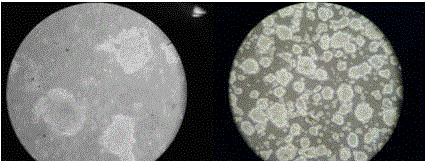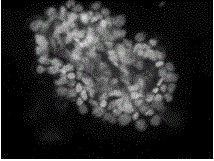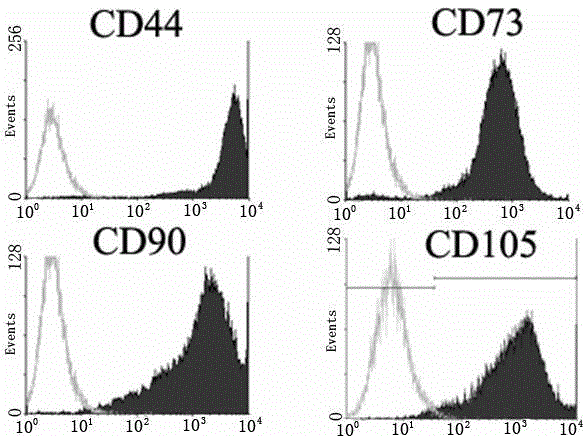Isolation and culture method of placenta mesenchyma precursor stem cells
A technology for isolating and culturing stem cells, applied in animal cells, vertebrate cells, bone/connective tissue cells, etc. It can solve the problems of low proliferation, influence effect and application scope, and decrease in the positive rate of CD271, and achieve the ability to proliferate and differentiate. strong effect
- Summary
- Abstract
- Description
- Claims
- Application Information
AI Technical Summary
Problems solved by technology
Method used
Image
Examples
Embodiment 1
[0024] Example 1: Isolation and culture method of placental mesenchymal precursor stem cells
[0025] 1. Aseptically collect the placenta of full-term infants, and wash the blood clot with 2 L of phosphate buffered saline containing gentamicin (100 U / ml) and heparin (50 U / ml);
[0026] 2. Separate the chorion and amniotic membrane, mechanically remove the decidua tissue with tissue forceps, rinse the chorion and blood vessels with PBS, and cut into pieces (2mm×2mm);
[0027] 3. Digest with 0.1% collagenase Ⅰ and tissue dispase Ⅱ by shaking at 37°C for 1 hour;
[0028] 4. Then digest with 0.05% trypsin for 0.5 hours;
[0029] 5. Dilute with a large amount of phosphate buffer, and filter tissue residue with a 200-mesh filter. Centrifuge at 2000rpm for 10min, resuspend in phosphate buffer;
[0030] 6. Discontinuous density gradient centrifugation: Add 50%, 30%, 20%, 10% Percoll solution in sequence, centrifuge at 2500rpm for 20min in discontinuous density gradient, and absorb ...
Embodiment 2
[0041] 1) Isolation of placental tissue: Aseptically collect the placenta, using toothed forceps and a scalpel to separate the chorion and amniotic membrane by conventional methods, wash the chorion and blood vessels with PBS, and cut into 2mm×2mm pieces;
[0042] 2) Combined enzyme digestion: 1% collagenase Ⅰ and 1% tissue dispase Ⅱ, 37 ° C for 6 hours, then digested with 0.25% trypsin for 1 hour; dilute with 5LPBS or αMEM, and filter the tissue residue with a 200-mesh filter .
[0043] 3) Discontinuous density gradient separation: use 50% Percoll solution, centrifuge at a density gradient of 2500rpm for 20min, absorb single cells between 30%Percoll, and wash twice by PBS centrifugation;
[0044] 4) Add neurotrophic factor receptor mouse anti-human CD271 monoclonal antibody, incubate for 30 minutes, wash twice with PBS, centrifuge at 1500 rpm for 5 minutes; add magnetic bead-labeled secondary antibody anti-mouse IgG1, incubate at 2-8°C for 15 minutes, wash twice with PBS, Ce...
Embodiment 3
[0047] 1) Isolation of placental tissue: Aseptically collect the placenta, using toothed forceps and a scalpel to separate the chorion and amniotic membrane by conventional methods, wash the chorion and blood vessels with PBS, and cut into 2mm×2mm pieces;
[0048] Combined enzyme digestion: 0.5% collagenase Ⅰ and 0.5% tissue dispase Ⅱ, 37 ° C shaking digestion for 3 hours, and then digested with 0.15% trypsin for 0.5 hours; dilute with 3.5 LPBS or αMEM, and filter the tissue residue with a 200-mesh filter;
[0049] 2) Discontinuous density gradient separation: use 50% Percoll solution, centrifuge at a density gradient of 2500rpm for 20 minutes, absorb single cells between 30% Percoll, and wash twice with PBS;
[0050] 3) Add neurotrophic factor receptor mouse anti-human CD271 monoclonal antibody, incubate for 30 min, wash twice with PBS, centrifuge at 1500 rpm for 5 min; add magnetic bead-labeled secondary antibody anti-mouse IgG1, incubate at 2-8°C for 15 min, wash twice with ...
PUM
 Login to View More
Login to View More Abstract
Description
Claims
Application Information
 Login to View More
Login to View More - R&D
- Intellectual Property
- Life Sciences
- Materials
- Tech Scout
- Unparalleled Data Quality
- Higher Quality Content
- 60% Fewer Hallucinations
Browse by: Latest US Patents, China's latest patents, Technical Efficacy Thesaurus, Application Domain, Technology Topic, Popular Technical Reports.
© 2025 PatSnap. All rights reserved.Legal|Privacy policy|Modern Slavery Act Transparency Statement|Sitemap|About US| Contact US: help@patsnap.com



